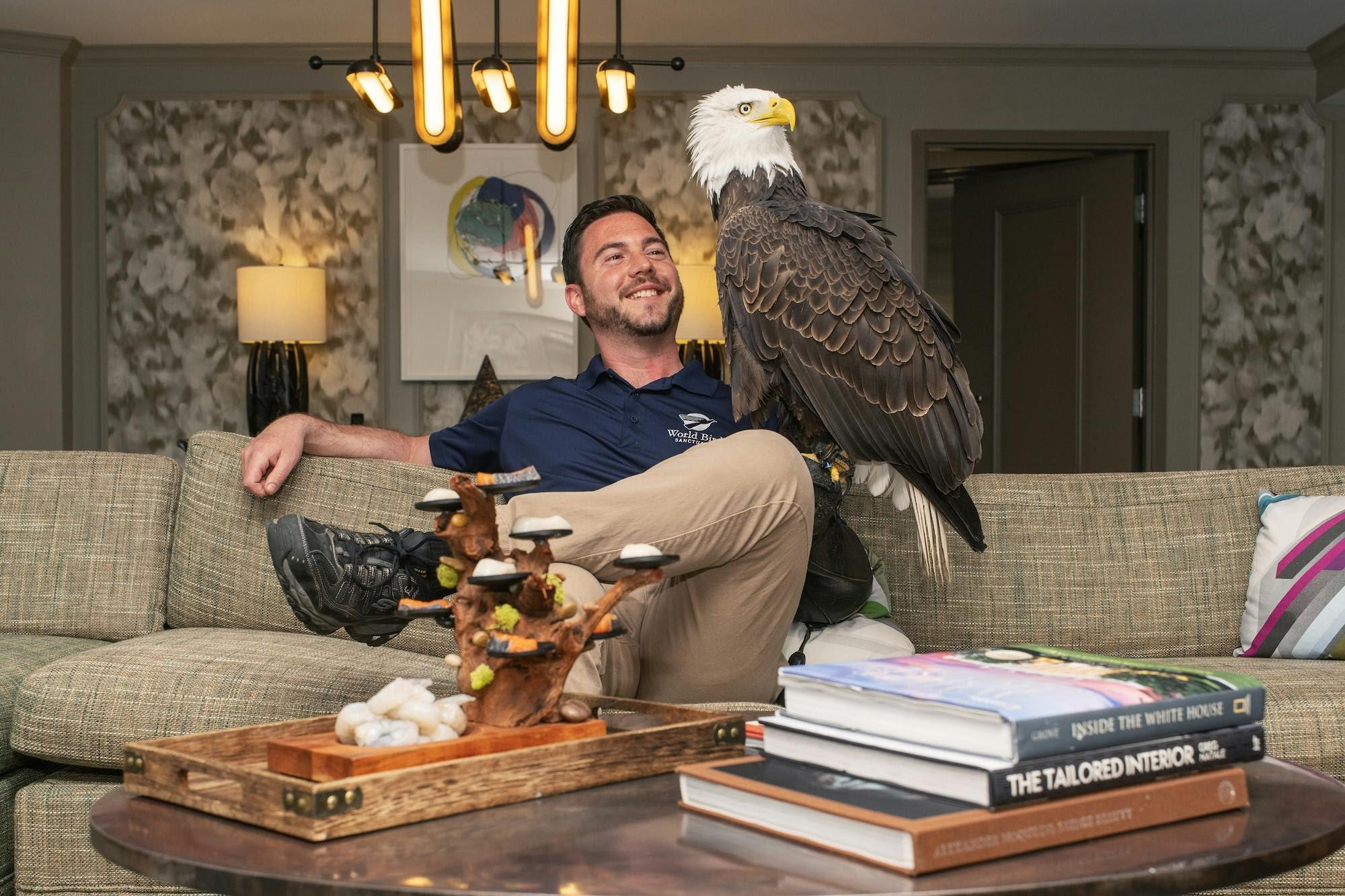Bald eagle lands in D.C. decades after his dad helped revive the species
Clark, a 21-year-old bald eagle, is the offspring of Ronald Reagan’s eaglet
“I don’t know how many times I’ve heard the pilot make that joke,” said Daniel Cone, Clark’s handler. “And every pilot thinks they were the first to say it.”
Like many passengers who touch down in the nation’s capital, Clark has a pretty high profile.
His eagle father, Captain, was given as a gift to President Ronald Reagan in 1982 by West German Chancellor Helmut Schmidt. The president received two eaglets in total: Captain and his sister, Carol.
At the time, the bald eagle — the national bird of the United States since 1782 — was endangered, and environmentalists were concerned about the gift.
Reagan was only able to keep the pair because of an interpretation of the 1940 Bald and Golden Eagle Protection Act that allowed the federal government to import or export the birds, while banning all others from doing so.
Reagan held on to the birds for a few years, then sent Captain to the World Bird Sanctuary in Valley Park, Mo., in 1988, and Carol went to the National Zoo in D.C.
Captain became part of a critical conservation breeding program, fathering about six healthy eaglets that were released into the wild. The sanctuary’s work to revive the bald eagle population was part of a broader effort across the country — which served its purpose. In 2007, the bald eagle was removed from the list of threatened and endangered species.
“It was a success story; the species was saved,” said Cone, 31, who started volunteering with the World Bird Sanctuary when he was 13 and is now the assistant executive director. “We almost lost our national symbol.”
At its low point, the bald eagle population in 1963 had fallen to 417 known nesting pairs. In 2021, there were more than 300,000 bald eagles across the country.
While Clark’s siblings were released into the wild, Clark hatched in 2003 with a deformity that probably would have led to his quick demise in nature.
“Clark hatched with bad feet,” Cone said. “His feet did not form properly and just didn’t give him the protection that he would need.”
“The wild is not the most forgiving place,” he added.
Clark has spent his whole life under human care and become a conservation ambassador and VIB (very important bird). He travels across the country to perform flight demonstrations and other educational programs at events including fundraisers and sports games. His father died in 2018.
Clark, who is just under eight pounds and about 30 inches tall, has taken more than 100 commercial flights.
Through a partnership with Southwest Airlines, Clark glides past airport queues and gets a special escort through the TSA line. He is the first passenger on the plane, and the first passenger off. Plus, he gets plenty of snacks before and after the flight — including his favorites, rats and mice.
“Clark gets all the food he wants,” said Cone, adding that Clark is very well-behaved. “You’d never know he’s there except for the big travel carrier that he’s in.”
Of course, people wonder what’s in the big black box, and Cone doesn’t hesitate to give them a peek.
“Everybody comes up to see him,” he said. “They’re blown away. It’s a moment they’ll never forget.”
People react similarly when they see him at events. Cone said Clark’s physical presence leaves a lasting impression and encourages people to care more about conservation efforts.
“There are things that every single person can do to make a difference, and make sure that the species continues,” said Cone, listing a few examples: “Volunteer at your local wildlife rehabilitation center; plant native plants in your yard; contribute to citizen science projects by observing birds in your area.”
“Or, if you’re really ambitious,” he said, “consider a career in wildlife conservation.”
When Clark performs at events, he flies between two trainers — typically to the tune of “The Star-Spangled Banner” — and is rewarded with a big treat when he’s finished. On Friday, Clark will attend Horatio Alger Association’s annual award ceremony.
When they travel, Clark and Cone share a hotel room.
“We lay a tarp down, put a perch down. We give him his own little bath that we take with us and turn the TV on, so he’s got something to watch,” said Cone, adding that they only stay at animal-friendly hotels.
“He’s very quiet,” Cone said. “It’s as normal as it can be having a bald eagle in the hotel.”
Cone has come to adore Clark’s quirks.
“He’s got such a big personality. He’s curious; he can be sassy,” he said. “He’s kind of like a cat, where he knows he has a whole staff that’s going to be at his beck and call.”
This trip, they’re lodging at the Darcy, a boutique hotel in downtown D.C. where they stayed last year. Upon his arrival Tuesday, Clark was served fresh seafood in the lobby, including scallops, wild salmon and Gulf shrimp.
“Having Clark soar into the Darcy is a once-in-a-lifetime experience,” said James Ryan, the general manager of the hotel. “I think it’s fantastic.”
Other hotel guests, he said, have been pleasantly surprised by the bird.
“They’ve got a great story to tell,” said Ryan.
Wild bald eagles typically live to be about 25 years old, Cone said, and if they’re in human care, they can reach 40 or older. Clark has many more years of travel and important work ahead of him.
“He’s an ambassador for his species,” said Cone.
To Support Buzzin News, Buy Me A Coffee. Thank You.















